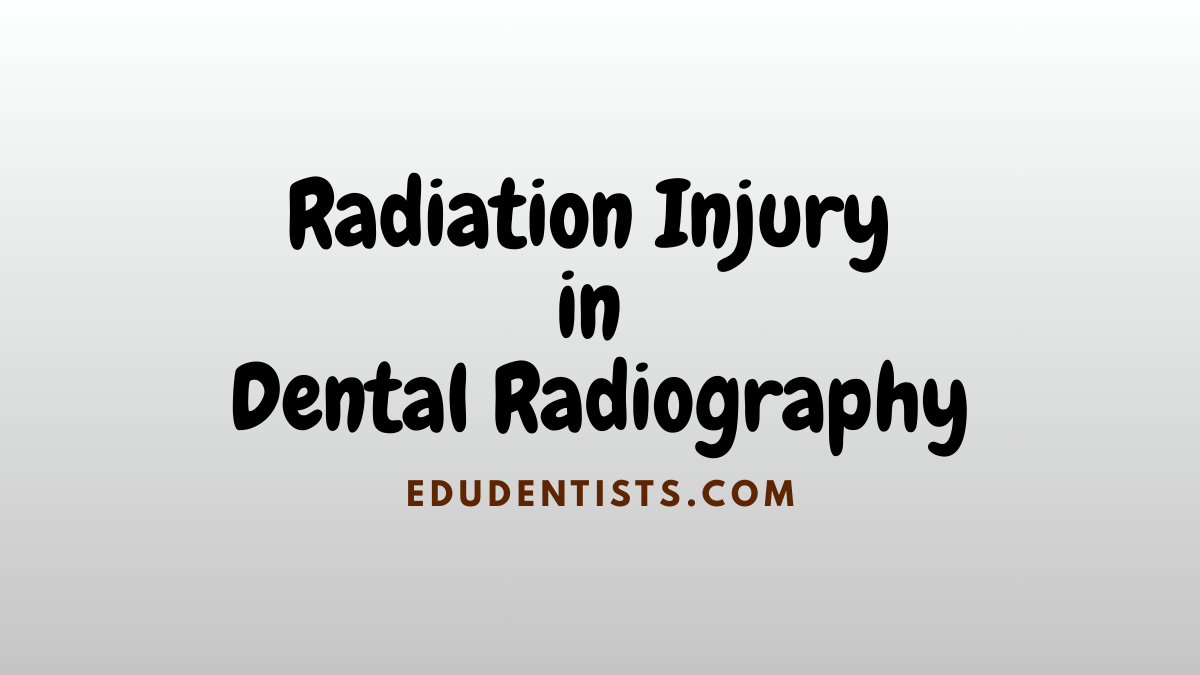
Radiation Injury in Dental Radiography
📸 How Radiation Causes Injury
When x-rays are used in dental imaging, some radiation is absorbed by the patient’s tissues. This can cause biologic damage through two main mechanisms:
1. Ionization
- X-rays ionize atoms in tissues (remove electrons), forming:
- A positive ion (atom)
- A free electron
- These particles can cause:
- DNA damage
- Broken molecular bonds
- Disruption of cell function
2. Free Radical Formation
- X-rays ionize water molecules (most of the body is water).
- This creates highly reactive free radicals like:
- Hydrogen (H•)
- Hydroxyl (OH•)
- These unstable particles:
- Can form toxins (like hydrogen peroxide H₂O₂)
- Damage cells and tissues indirectly
📚 Theories of Radiation Damage
🔹 Direct Theory
- X-ray photons hit critical cell structures (e.g., DNA) directly.
- Causes immediate damage.
- Less common—most x-rays pass through cells without impact.
🔹 Indirect Theory
- X-rays ionize water → free radicals form.
- Free radicals combine to form toxins → damage cells.
- More common due to high water content in cells (70–80%).
📈 Dose–Response Curve
- Shows relationship between dose received and damage caused.
- Follows a linear, nonthreshold model:
- Linear: More radiation → more damage.
- Nonthreshold: Even the smallest dose causes some damage.
- Conclusion: No completely safe dose exists.
⚠️ Types of Radiation Effects
1. Stochastic Effects
- Random: Likelihood increases with dose, but severity does not.
- No threshold.
- Examples:
- Cancer
- Genetic mutations
2. Nonstochastic (Deterministic) Effects
- Have a threshold dose.
- Severity increases with dose.
- Require higher doses.
- Examples:
- Skin redness (erythema)
- Hair loss
- Cataracts
- Infertility
🕒 Sequence of Radiation Injury
- Latent Period
- Time between exposure and appearance of symptoms.
- Shorter when dose is high or fast.
- Period of Injury
- Effects seen at the cellular level:
- Cell death
- DNA/chromosome damage
- Abnormal cell division
- Effects seen at the cellular level:
- Recovery Period
- Some cellular damage can be repaired.
- However, not all damage heals.
- Cumulative Effects
- Repeated exposure adds up over time.
- Can lead to:
- Cancer
- Cataracts
- Genetic disorders
🔬 Factors That Affect Radiation Injury
- Total dose: Higher energy → more damage.
- Dose rate: Faster exposure = less time for cells to repair.
- Area exposed: Whole-body exposure is more harmful.
- Cell sensitivity: Rapidly dividing cells (like young or cancer cells) are more sensitive.
- Age: Children are more sensitive to radiation than adults.
⏱️ Short-Term vs Long-Term Effects
Short-Term Effects
- Seen minutes to weeks after high-dose exposure (e.g., nuclear accident).
- Example: Acute Radiation Syndrome (ARS)
- Nausea, vomiting, hair loss, bleeding
- Not relevant to dental radiography.
Long-Term Effects
- Appear years or generations later.
- Caused by repeated low-level exposure.
- Examples:
- Cancer
- Birth defects
- Genetic mutations
👥 Somatic vs Genetic Effects
| Type | Affected Individual | Heritable? | Examples |
|---|---|---|---|
| Somatic | The person exposed | ❌ No | Cancer, leukemia, cataracts |
| Genetic | Offspring only | ✅ Yes | Birth defects, inherited mutations |
📋 Table: Radiation Effects on Different Tissues
| Tissue/Organ | Radiation Effect |
|---|---|
| Bone marrow | Leukemia |
| Reproductive cells | Genetic mutations |
| Salivary glands | Carcinoma |
| Thyroid | Carcinoma |
| Skin | Carcinoma |
| Lens of the eye | Cataracts |
Radiation Effects in Dental Radiography
Understanding radiation effects is essential for ensuring safe and effective use of dental radiographs. The biological impact of radiation depends on several key factors, including the total dose, dose rate, volume of tissue exposed, cellular sensitivity, and the patient’s age.
Short-Term vs. Long-Term Effects
- Short-term effects result from high doses absorbed over a short time, potentially leading to acute tissue damage.
- Long-term effects occur when low doses are absorbed repeatedly over extended periods. These may contribute to chronic health conditions or increased cancer risk.
Somatic vs. Genetic Effects
- Somatic effects appear in the exposed individual and may affect tissues and organs.
- Genetic effects involve damage to reproductive cells and can be passed on to future generations.
Cellular Sensitivity to Radiation
Cell response to radiation is influenced by:
- Mitotic activity (how often the cell divides),
- Differentiation level (how specialized the cell is), and
- Metabolic rate (cellular activity level).
Radiosensitive cells (more vulnerable to radiation) include:
- Blood cells
- Immature reproductive cells
- Young bone-forming cells
- Epithelial tissue cells
Radioresistant cells (more resilient to radiation) include:
- Mature bone cells
- Muscle tissue
- Nerve cells
Radiation Measurement Units
- Exposure: Measured by the amount of ionization in the air, using roentgen (R) or coulombs per kilogram (C/kg).
- Absorbed Dose: The amount of energy absorbed by tissues, measured in rads (traditional unit) or grays (Gy) (SI unit).
- Dose Equivalent: Considers the biological effect of different types of radiation. Measured in rem or sievert (Sv).
Radiation Risk in Dental Imaging
The level of radiation exposure from dental radiographs is relatively low and is considered comparable to risks of common daily activities. Nonetheless, patient safety remains a top priority, and every effort should be made to minimize exposure.
Factors influencing patient radiation dose include:
- Film speed (faster film reduces exposure),
- Collimation (rectangular collimators limit radiation scatter),
- Technique (long-cone paralleling technique reduces skin dose),
- Exposure settings (higher kVp can reduce absorbed dose).
Risk-Benefit Consideration
Dental radiographs should only be prescribed when clinically necessary. The diagnostic benefit must always outweigh the potential risk of radiation exposure.
Reference:
Iannucci, J. M., & Howerton, L. J. (2017). Dental Radiography: Principles and Techniques (5th ed.). St. Louis, MO: Elsevier.